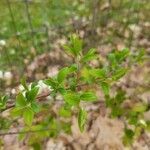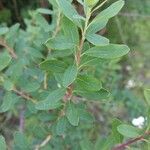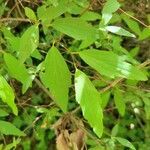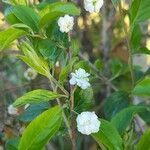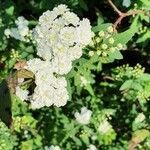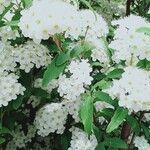Shrubs, 3–20 dm, ?not rhizomatous?. Stems arching, branched. Leaves ?sometimes partly persistent?; petiole 3–10 mm; blade rhombic-lanceolate, 2–7 × 0.5–2 cm, membranous to chartaceous, base cuneate to obtuse, margins coarsely serrate or irregularly 3-fid to slightly lobed distally, venation pinnate simple craspedodromous, secondary veins not prominent, apex acute, abaxial surface ?blue-green, glaucous?, glabrous, adaxial ?dark green?, glabrous. Inflorescences mostly axillary, corymbiform or hemispheric panicles, 2–5 × 2–5 cm; ?filiform bractlets sometimes present at base?; branches glabrous or pubescent. Pedicels 10–20 mm, glabrous or pubescent. Flowers ?often double-flowered, usually distinct?, 10–15 mm diam.; hypanthia campanulate to turbinate, 3–5 mm, abaxial surface glabrous or sparsely hairy, adaxial glabrous; sepals deltate, 1–1.5 mm; petals white, elliptic to orbiculate, 2–4 mm; staminodes 10–12; stamens 20–28, 0.5–1 times petal length. Follicles inflated cymbiform, 0.5–2 mm, glabrous.
Deciduous or semi-deciduous, glabrous shrub up to c. 2 m high, forming dense thickets; stems erect at first, arching to horizontal from second year; bark reddish and becoming papery, deep brown on older stems. Lvs spreading to ascending; petiole 3-10 mm long, narrowly winged, reddish, channelled above; blade lanceolate or narrowly elliptic to rhombic (especially on vegetative shoots), 30-75-(90) × 7-25-(30) mm, acute, narrowly cuneate at base, pale to dark green on both surfaces, with primary veins obvious and sometimes purplish, irregularly and deeply 1-2-serrate to lobed, especially in upper 1/2 of blade. Infls glabrous, spreading, compound corymbs terminating short lateral branches, up to 30-(40) mm wide and 20 mm long; peduncles up to 12 mm long. Sepals broadly triangular, 1-2 mm long, greenish. Petals suborbicular, 3-4 × 2-3 mm, white. Stamens < petals. Fr. of erect, glabrous, dark follicles.
Shrub with thin, flexuous, glabrous branches. Petiole 0.5-1 cm. Leaves oblong, (bi)serrate, 3-7 by 1-3 cm, glabrous, ± glaucous underneath. Corymbs axillary, shortly peduncled, with c. 10-20 flowers, pedicels 7-15 mm. Margin of disc lobed. Stamens in normal flowers 20-24. Pistils (3-)5.
A shrub. It grows 1-2 m high. The small branches are brown. The leaves are almost round and 2-3 cm long and wide. There are teeth along the edge. The leaves often have 3 lobes. They are bluish-green underneath. The flowers are white. There are in a dense group on short branches.
